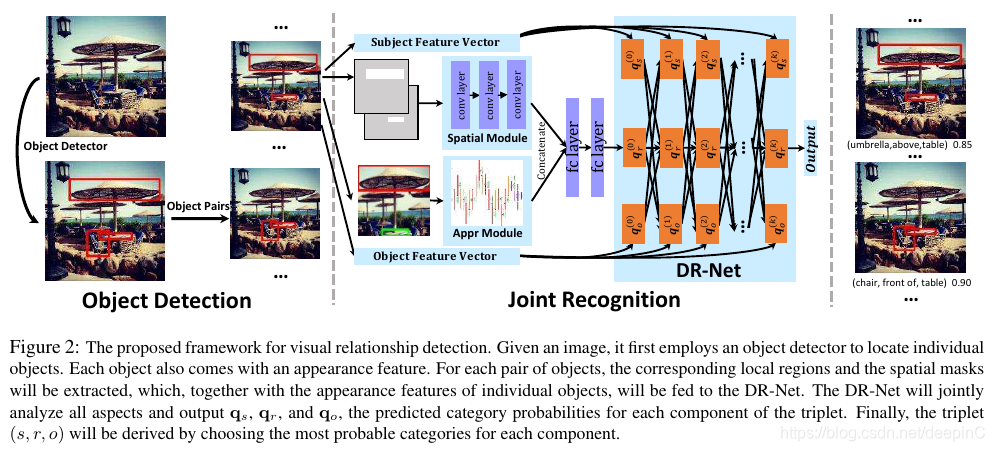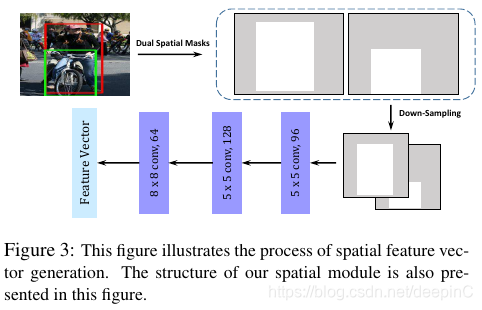(这里仅记录了论文的一些内容以及自己的一点点浅薄的理解,具体实验尚未恢复。由于本人新人一枚,若有错误以及不足之处,还望不吝赐教)
总结
-
previous works 的缺点
将 VRD 视为分类问题,即 consider each type of relationship (1, e.g.e.g.e.g. “ride”) or each distinct visual phrase (2, e.g.e.g.e.g. “person-ride-horse”) as a category
对于第(1)种,存在如下问题:increase diversity within each class,即虽然解决了第(2)中数量庞大的问题,使得类别数量大大减少,但是类内的 object-pairs 类别的差异可能会很大且不同类之间 object-pairs 的差异可能会很不一致,使得模型难以拟合;对于第(2)中,存在 ① 组合数量庞大,所需训练的分类器数量多(一种组合训练一个分类器);②由于 long-tail 分布,即每种类别所包含的样本数量差异大,有些包含很少样本,使得对应的分类器得不到充分的训练
-
本文提出了 DR-Net (Deep Relational Network) 用于 exploit the statistical dependencies between objects and their relations/predicates
-
contributions:
- DR-Net, a novel formulation that combines the strengths of statistical models and deep learning
- an effective framekwork for visual relationship detection, which brings the state-of-the-art to a new level
-
缺点:将关系检测视为一个多分类问题,忽略了多关系的情况,即 co-occurrence of predicates (预测使用了softmaxsoftmaxsoftmax 函数)
模型框架

-
三个 stages
- Object Detection: 使用 Faster RCNN 来检测物体,每个物体带有 a bounding box & an appearance feature
- Pair Filtering: 产生 object pairs,然后引入一个浅层 NN 作为 filter 去除一些明显不成立的 object pair。该 filter 会综合 spatial configurations (e.g.e.g.e.g. objects too far away are unlikely to be related) 和 object categories (e.g.e.g.e.g. certain objects are unlikely to form a meaningful relationship) 从而过滤
- Joint Recognition: 以每个 object pair 作为输入,包括对应的两个 object 的 ① appearance feature(源于 object detection)、根据 bounding box 所获取的 masks 和二者的区域图,其中,masks 通过一个三层卷积来提取 ② spatial feature(Spatial Module),具体过程如下图 3 所示。而区域图则通过 VGG16/ResNet-101 来提取 ③ appearance feature(Appr Module)。然后将 ② 和 ③ concatenate 起来作为两层全连接层的输入以获得 ④ compressed pair feature。最后将 ① 和 ④ 作为 DR-Net 的输入,输出则是一个关系的概率分布表 P(r∣s,o)∈R∣P∣P(r|s,o) \in R^{|P|}P(r∣s,o)∈R∣P∣(softmaxsoftmaxsoftmax),其中 ∣P∣|P|∣P∣ 表示关系数据集的大小,取最大概率对应的 rrr 作为最后的预测结果
在训练时,这三个阶段是独立训练的

-
DR-Net
该网络是基于 CRF 条件随机场进行推导获得的,最终的迭代公式为:
(1)qs′=σ(Waxs+Wsrqr+Wsoqo)qr′=σ(Wrxr+Wrsqs+Wroqo)qo′=σ(Waxo+Worqr+Wosqs) \begin{array}{l} \mathbf{q_s}' = \sigma(\mathbf{W}_a\mathbf{x}_s + \mathbf{W}_{sr}\mathbf{q}_r + \mathbf{W}_{so}\mathbf{q}_o) \\ \mathbf{q_r}' = \sigma(\mathbf{W}_r\mathbf{x}_r + \mathbf{W}_{rs}\mathbf{q}_s + \mathbf{W}_{ro}\mathbf{q}_o) \\ \mathbf{q_o}' = \sigma(\mathbf{W}_a\mathbf{x}_o + \mathbf{W}_{or}\mathbf{q}_r + \mathbf{W}_{os}\mathbf{q}_s) \end{array} \tag{1}








 本文介绍了DR-Net,一种结合统计模型与深度学习的关系检测新方法,针对视觉关系检测的挑战,如长尾分布和类内多样性。DR-Net由对象检测、对过滤和联合识别三个阶段组成,通过RNN实现条件随机场的迭代公式,提高了关系预测的准确性。实验结果显示DR-Net提升了状态-of-the-art的表现。
本文介绍了DR-Net,一种结合统计模型与深度学习的关系检测新方法,针对视觉关系检测的挑战,如长尾分布和类内多样性。DR-Net由对象检测、对过滤和联合识别三个阶段组成,通过RNN实现条件随机场的迭代公式,提高了关系预测的准确性。实验结果显示DR-Net提升了状态-of-the-art的表现。
 最低0.47元/天 解锁文章
最低0.47元/天 解锁文章
















 1322
1322

 被折叠的 条评论
为什么被折叠?
被折叠的 条评论
为什么被折叠?








